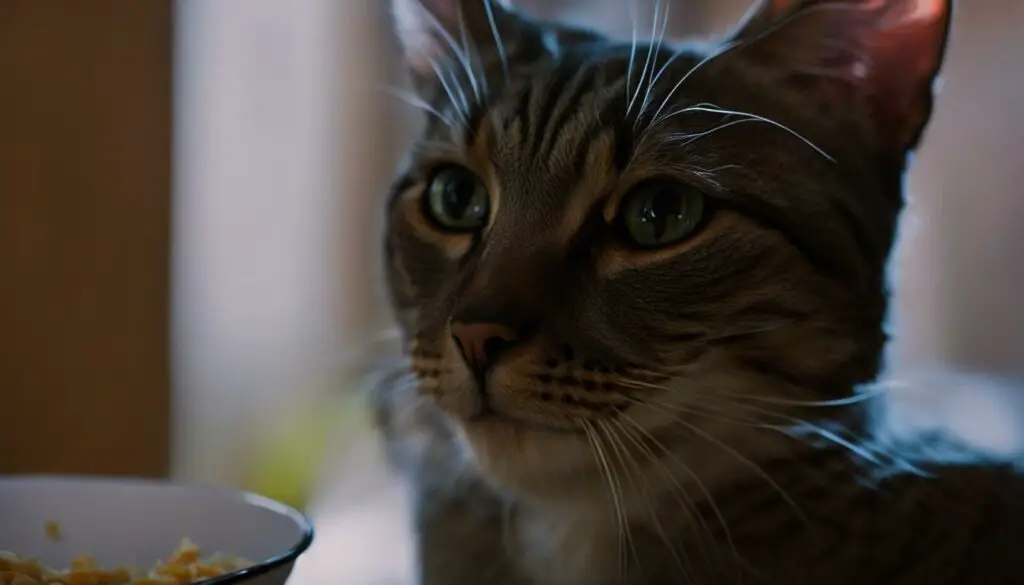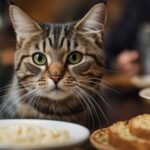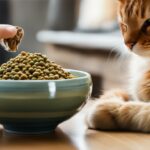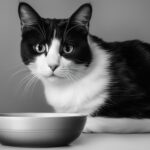It can be puzzling and frustrating when your cat refuses to eat unless you are watching. This behavior is not uncommon among felines and can have various reasons behind it. Understanding the intricacies of this behavior is crucial for creating a harmonious mealtime routine for your pet.
Key Takeaways:
- Some cats refuse to eat unless their owners are present, seeking attention and security.
- Understanding your cat’s eating patterns and preferences can help you tailor their mealtime experience.
- There can be several reasons why a cat refuses to eat unless their owner is present.
- Strategies to encourage eating include sitting with your cat, using interactive toys, and ensuring fresh and appealing food.
- Consider any underlying health issues and consult with a veterinarian if necessary.
The Psychology of Feline Eating Habits
Cats are fascinating creatures with unique eating habits. They are known for being selective and sometimes finicky when it comes to their meals. One interesting behavior that some cats exhibit is refusing to eat unless their owners are present. While this behavior can be puzzling to us humans, it is important to understand the psychological reasons behind it.
Cats are naturally social animals and form strong bonds with their owners. They rely on the presence and attention of their owners to feel safe and secure. This is especially true during mealtime, as cats see it as an important bonding opportunity. When their owners are present, cats feel reassured and more inclined to eat. It’s their way of seeking attention and affection from their trusted humans.
This behavior also stems from a cat’s instinctual nature. Cats are predators by nature, and in the wild, they would hunt for their food. By eating in the presence of their owners, cats feel more protected and secure, mimicking the feeling of a shared hunt. They instinctively know that their owners will keep them safe while they indulge in their meal.
The Importance of Bonding and Security
Creating a strong bond with your cat is crucial for their overall well-being. Understanding their need for attention and security during mealtime is an important aspect of that bond. By being present and attentive while they eat, you can provide them with the love and care they crave. This positive reinforcement builds trust and strengthens your relationship with your feline companion.
While it may seem like a simple behavior, refusing to eat unless you’re watching is a reflection of the deep bond cats form with their owners. By understanding the psychology behind this behavior, you can create a more enjoyable and stress-free mealtime routine for your cat, enhancing their overall happiness and satisfaction.
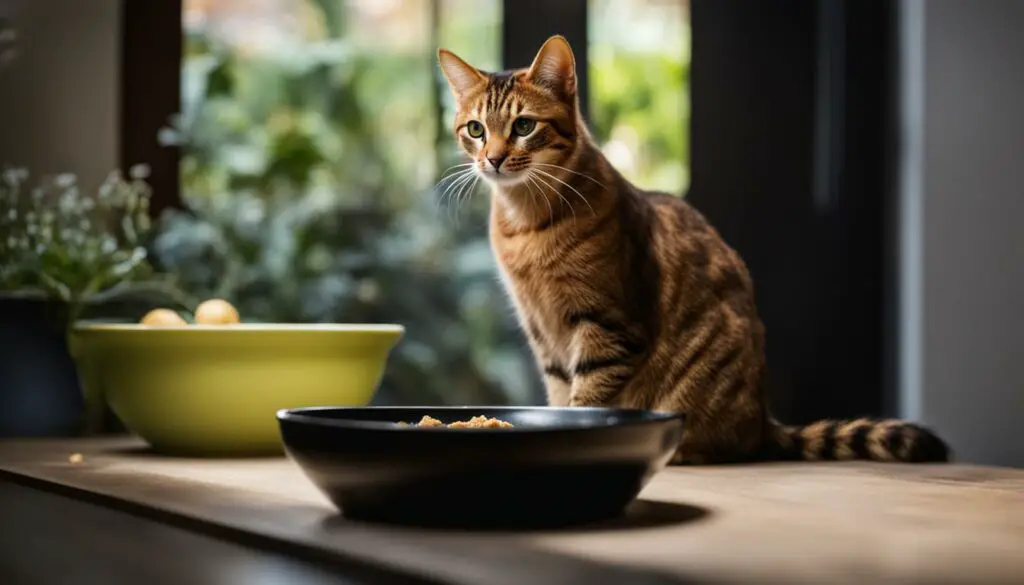
Table: Understanding the Psychology of Cats and their Eating Habits
| Behavior | Possible Explanation |
|---|---|
| Refusing to eat unless owner is present | Seeking attention and security |
| Eating in the presence of the owner | Feeling protected and mimicking a shared hunt |
| Strong bonding during mealtime | Building trust and strengthening the human-feline relationship |
The Psychology of Feline Eating Habits
When it comes to their eating habits, cats are known for their unique preferences and behaviors. Some cats have a peculiar behavior of refusing to eat unless their owners are present. This behavior can stem from their need for attention and security. As interactive creatures, cats form strong bonds with their owners, and having their owner present during mealtime provides reassurance and a sense of safety.
To understand why your cat won’t eat unless you’re watching, it’s crucial to analyze their eating patterns and preferences. Observe if there are specific times or situations when they exhibit this behavior. Pay attention to the type of food they prefer and if they have any aversions. By analyzing these patterns and preferences, you can gain insights into their motivations and tailor their mealtime experience accordingly.
Creating a calm and engaging mealtime environment is essential for cats with this behavior. By being present and attentive during their meals, you can provide the attention they seek and strengthen your bond with them. Additionally, consider incorporating interactive toys or puzzles into mealtime to stimulate their interest in food. Ensuring that the food is fresh and appealing to their taste buds can also increase their motivation to eat.
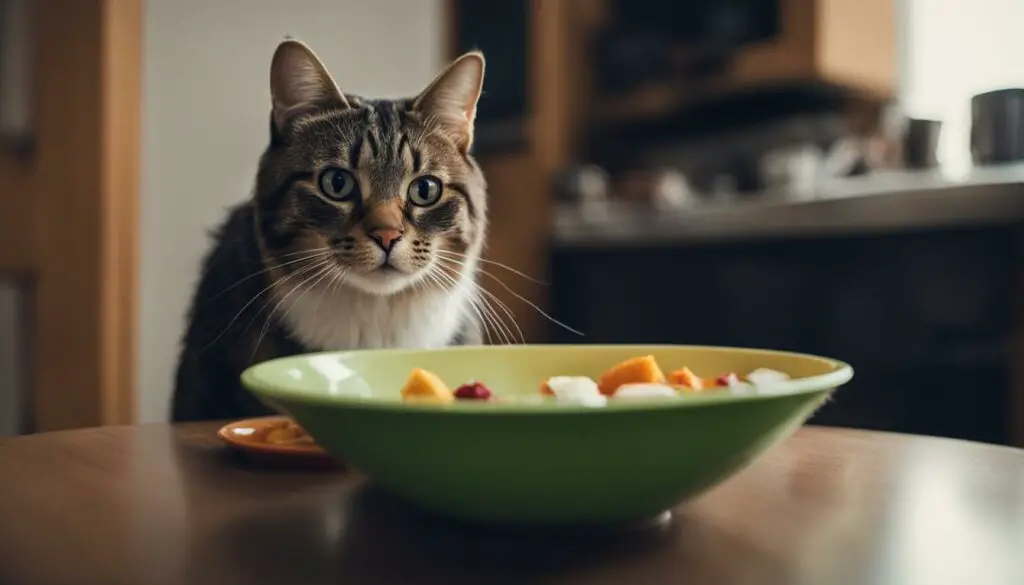
Table: Analyzing Cat’s Eating Behavior
| Behavior | Possible Meaning |
|---|---|
| Eating only when owner is present | Desire for attention and security |
| Eating at specific times or situations | Routine and comfort |
| Preference for certain types of food | Individual taste and texture preferences |
| Avoidance of certain foods | Dislike or sensitivity to specific ingredients |
The Reasons Behind Your Cat Refusing to Eat Unless You’re Watching
It can be perplexing when your cat insists on your presence during mealtime. Understanding the reasons behind this behavior is crucial for creating a harmonious eating routine for your furry friend.
There can be several reasons why cats refuse to eat unless their owners are present. One possible explanation is separation anxiety. Cats are naturally sociable creatures and may feel more secure when their owners are around. The presence of their owner during mealtime provides comfort and reassurance.
Some cats simply have a preference for interactive mealtime experiences. They enjoy the attention and affection they receive when their owner is watching. The act of being observed can add an extra level of stimulation and make the mealtime more engaging for them.
Reasons for Cats Refusing to Eat Unless You’re Watching
“Cats may refuse to eat unless their owners are present due to separation anxiety or a preference for interactive mealtime experiences.”
Understanding the reasons behind your cat’s behavior is essential for addressing it effectively. By recognizing their need for attention and security, you can create a calm and engaging mealtime environment that meets their emotional needs. This may involve sitting with them during meals, using interactive toys, or simply providing verbal encouragement and praise.
| Reasons for Refusal | Explanation |
|---|---|
| Separation anxiety | Cats feel more secure when their owner is present. |
| Preference for interaction | Cats enjoy the attention received when their owner is watching. |
However, it’s important to note that if your cat consistently refuses to eat, it’s advisable to consult with a veterinarian. They can rule out any underlying health issues that may be affecting your cat’s appetite and provide appropriate guidance for addressing their refusal to eat unless you’re present.
Remember, each cat is unique, and their mealtime preferences can vary. By observing and understanding your cat’s behavior, you can tailor their mealtime routine to create a positive and enjoyable dining experience.
Understanding the Interactive Relationship
When it comes to our cats’ eating habits, it’s important to recognize the interactive relationship they have with us, their owners. Some cats refuse to eat unless they receive attention and interaction during mealtime. This behavior stems from their natural desire for socialization and bonding.
Cats are interactive creatures that form strong bonds with their owners. They seek attention and love, and mealtime provides an opportunity for this interaction. By being present and engaged during their meals, we can create a positive and rewarding experience for our cats.
During mealtime, try gently petting or talking to your cat to show them love and care. This can help them feel more comfortable and secure while eating. Additionally, you can use this time to observe their behavior and ensure they are enjoying their food.
| An Interactive Mealtime Experience | A Non-Interactive Mealtime Experience |
|---|---|
| Increased interest in food | Decreased motivation to eat |
| Enhanced bonding and trust | Potential for anxiety or stress |
| Opportunity for monitoring food intake | Less awareness of eating habits |
By understanding and embracing the interactive relationship between you and your cat during mealtime, you strengthen the bond between you and ensure a harmonious dining experience.
Strategies to Encourage Eating
If your cat has a preference for eating when you’re watching, there are strategies you can use to encourage their eating. One approach is to sit with them during mealtime and provide verbal encouragement and praise. Another option is to use interactive toys or puzzles that can stimulate their interest in food. Additionally, ensure that the food is fresh and appealing to their taste buds to increase their motivation to eat.
Creating a positive and engaging mealtime experience can make a significant difference in your cat’s eating habits. Experiment with different types of food to find one that your cat enjoys. Consider introducing variety and texture to stimulate their interest. You can incorporate treats or mix in a small amount of wet food to enhance the aroma and taste.
Table: Strategies to Encourage Eating
| Strategy | Description |
|---|---|
| Sit with your cat during mealtime | Provide verbal encouragement and praise |
| Use interactive toys or puzzles | Stimulate their interest in food |
| Ensure fresh and appealing food | Increase their motivation to eat |
| Experiment with different food options | Introduce variety and texture |
| Incorporate treats or small amount of wet food | Enhance aroma and taste |
In addition to these strategies, it’s important to maintain a calm and stress-free environment during mealtime. Avoid loud noises or distractions that can disrupt your cat’s focus on eating. Create a designated feeding area where they feel safe and comfortable.
If your cat continues to show a lack of interest in food, consult with your veterinarian to rule out any underlying medical conditions. They can provide further guidance and recommendations tailored to your cat’s specific needs. Remember, every cat is unique, so it may require some trial and error to find the best approach that encourages healthy eating habits.
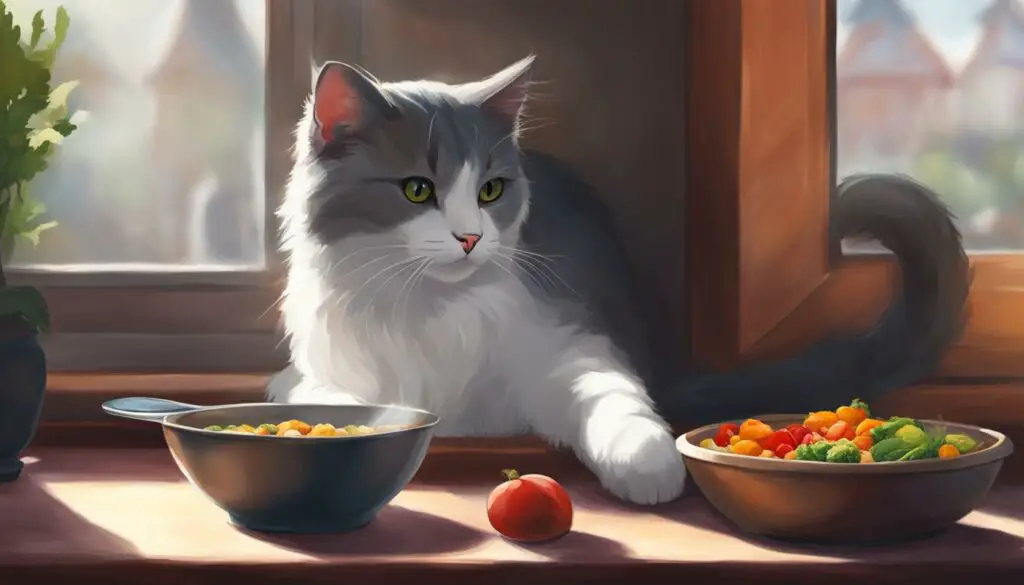
The Importance of Considering Health Issues
When your cat refuses to eat unless you’re watching, it’s essential to consider any underlying health issues that may be affecting their appetite. While psychological factors can contribute to this behavior, ruling out physical causes is crucial for their overall well-being. If your cat consistently exhibits this behavior, it’s recommended to consult with a veterinarian.
A veterinarian can conduct a thorough examination to assess your cat’s overall health and determine if there are any medical conditions impacting their appetite. They may perform blood tests, X-rays, or other diagnostic procedures to identify any underlying issues. By addressing these health concerns, you can ensure that your cat receives the appropriate treatment and support for their specific needs.
Common health issues that can affect a cat’s appetite include dental problems, gastrointestinal disorders, kidney disease, and infections. These conditions can cause discomfort or pain, leading to a decreased interest in food. Additionally, certain medications or treatments may also affect a cat’s appetite. By identifying and addressing these health issues, you can help your cat regain their appetite and ensure their nutritional needs are met.
| Common Health Issues | Symptoms |
|---|---|
| Dental problems | Difficulty chewing, drooling, bad breath |
| Gastrointestinal disorders | Vomiting, diarrhea, weight loss |
| Kidney disease | Increased thirst, frequent urination, weight loss |
| Infections | Fever, lethargy, loss of appetite |
Remember, if your cat consistently refuses to eat unless you’re watching, it’s important to consult with a veterinarian to ensure their health and well-being. By addressing any underlying health issues, you can help your cat regain their appetite and maintain their overall vitality.
Possible Solutions for Finicky Eating
If your cat is a picky eater and refuses to eat certain foods, there are several strategies you can try to encourage them to eat.
One approach is to experiment with different types of food and flavors. Cats can have specific preferences, and finding a food that appeals to their taste buds can help increase their interest in eating. You can also try mixing their regular food with a small amount of a new flavor to introduce them to new options.
Another strategy is to ensure that the food is at the right temperature and texture. Some cats prefer warm food, while others may be more inclined to eat if the food has a particular texture. By catering to their preferences, you can make mealtime more appealing for your finicky cat.
| Strategy | Description |
|---|---|
| Offer small, frequent meals | Serving smaller portions more frequently throughout the day can entice your cat to eat. This approach can also help prevent overeating and promote better digestion. |
| Try interactive feeding toys | Some cats enjoy the challenge of working for their food. Interactive feeding toys can engage their hunting instincts and make mealtime more fun and interactive. |
| Add flavor enhancers | Adding a small amount of flavor enhancers, such as bone broth or tuna water, to your cat’s food can make it more enticing. However, be cautious not to overdo it, as too much of these additives can upset your cat’s stomach. |
Remember, it’s essential to consult with your veterinarian if your cat consistently refuses to eat or shows signs of distress. They can provide guidance tailored to your cat’s specific needs and rule out any underlying health issues that may be affecting their appetite. With patience and experimentation, you can help your finicky eater find a diet that suits their preferences and nutritional needs.
Creating a Calm Mealtime Environment
When it comes to mealtime, creating a calm and peaceful environment for your cat can make a big difference in their eating behavior. Cats are sensitive creatures, and distractions or anxiety-inducing factors can hinder their appetite. By setting up a serene mealtime environment, you can help alleviate any potential stress and ensure your cat feels comfortable enough to eat.
To create a calm mealtime environment, find a designated area for your cat’s meals where they can eat undisturbed. This can be a quiet corner of your home or a specific room where they feel safe. Minimize any loud noises or sudden movements that may startle or distract your cat while they’re eating. By providing them with a peaceful space, you’re allowing them to focus solely on their food and enjoy the meal without any external disturbances.
Another important aspect of creating a calm mealtime environment is to monitor your cat’s food intake. Keep an eye on how much they’re eating and if there are any changes in their appetite. This observation can help you identify any potential issues or changes in their behavior that may require attention. Monitoring their food intake ensures you’re aware of their eating habits and can address any concerns promptly.

Providing Regular Mealtimes
Establishing a consistent mealtime routine is essential for ensuring your cat’s nutritional needs are met and creating a sense of predictability. By feeding your cat at regular intervals throughout the day, you can help regulate their appetite and reduce their dependence on your presence during meals. This routine provides them with a structured eating schedule and helps prevent them from becoming overly hungry or relying solely on your presence to stimulate their interest in food.
Regular mealtimes also promote healthy digestion and prevent overeating, which can lead to weight gain and other health issues. By providing balanced portions at specific times, you can maintain your cat’s overall well-being and prevent them from developing unhealthy eating habits.
Benefits of Regular Mealtimes:
- Regulates appetite and prevents overeating
- Promotes healthy digestion and prevents gastrointestinal issues
- Establishes a sense of routine and security for your cat
- Controls weight and prevents obesity-related health problems
When implementing regular mealtimes, it’s important to choose an appropriate feeding schedule based on your cat’s age, activity level, and dietary requirements. Consult with your veterinarian to determine the ideal feeding frequency and portion sizes for your feline companion. Additionally, ensure that fresh water is always available to help support their hydration needs.
| Meal Frequency | Portion Sizes |
|---|---|
| 2 meals per day | Divide their daily recommended portion into two meals |
| 3-4 meals per day | Divide their daily recommended portion into smaller meals |
| Free-feeding | Leave a measured amount of food out continuously |
By providing regular mealtimes, you can create a healthier and more balanced diet for your cat while also promoting their independence and self-regulation when it comes to food. This routine allows them to develop a natural eating pattern and ensures that they receive the necessary nourishment throughout the day, even when you’re not watching.

The Importance of Understanding Cat Psychology
Understanding the psychology of cats is essential for providing them with the care they need. Cats have unique behaviors and instincts that stem from their evolutionary history as independent and self-sufficient creatures. By delving into their psychology, we can gain insights into their behavior, preferences, and needs, ultimately enhancing their well-being.
Cats are highly perceptive animals and are sensitive to their environment. They rely on social cues and their senses to navigate their surroundings and interact with others. This includes their interactions with their owners. By understanding their psychology, we can create a deeper connection with our feline companions and foster a more harmonious relationship.
Key Aspects of Cat Psychology
- Social Behavior: Cats are social animals, but their social structure differs from that of dogs or humans. They are more independent and tend to form close bonds with their owners while maintaining a certain level of autonomy.
- Communication: Cats communicate through a combination of vocalizations, body language, and scent marking. Understanding these signals can help us interpret their needs and emotions.
- Territoriality: Cats have a strong territorial instinct and require a sense of security in their environment. Providing them with a safe and comfortable space is crucial for their well-being.
- Instinctual Behaviors: Cats have innate behaviors such as hunting, grooming, and marking. Understanding these behaviors can help us provide appropriate outlets and enrichment for them.
By understanding these key aspects of cat psychology, we can tailor our approach to their care and create an environment that meets their specific needs. Whether it’s providing appropriate social interactions, creating a safe and stimulating environment, or addressing their natural instincts, understanding cat psychology is the foundation for providing optimal care and strengthening our bond with our feline friends.

| Benefits of Understanding Cat Psychology | How it Enhances Cat Care |
|---|---|
| Improved communication | Allows for better interpretation of cat behavior and needs |
| Reduced stress and anxiety | Enables us to create a calm and comfortable environment |
| Enhanced well-being | Provides opportunities for mental and physical stimulation |
| Stronger bond with our cats | Promotes trust and understanding between cat and owner |
Building a Bond with Your Cat
When it comes to our beloved feline companions, building a strong bond is essential for their well-being and happiness. One way to foster this connection is by being present during their mealtime. By showing our presence and attentiveness while they eat, we can communicate love and care to our cats.
Engaging in gentle interactions, such as petting or talking to them, while they enjoy their meal can create a positive reinforcement. This reinforcing behavior can deepen our bond and create a sense of trust and security for our cats. It also allows us to monitor their eating habits and ensure they are receiving proper nutrition.
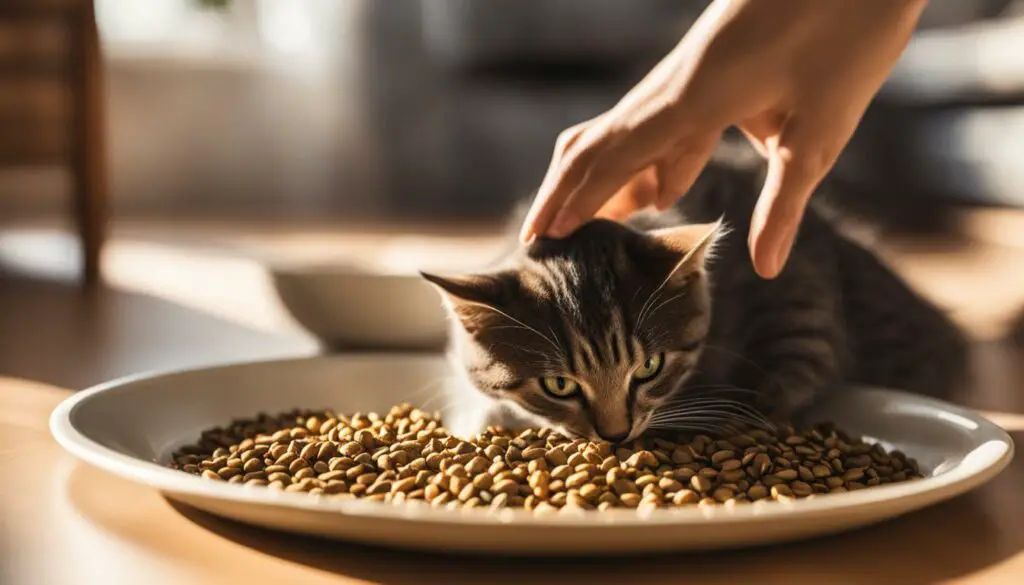
Mealtime can be a special opportunity to spend quality time with our cats and strengthen our relationship. By dedicating our presence and attention during their meals, we can demonstrate our dedication as their caretakers. The simple act of being there for our cats can make a significant difference in how they perceive us as their trusted companions.
The Benefits of Observing and Analyzing
Observing and analyzing your cat’s mealtime behavior can provide valuable insights into their needs and preferences. By closely observing their eating patterns and reactions to different food types, you can gather essential information that will help you tailor their meals and create a more enjoyable dining experience for your feline companion.
When you observe your cat’s mealtime behavior, pay attention to the time of day they are most interested in eating and any particular cues they give when they are hungry. You may notice that they become more active or start meowing at specific times, indicating they are ready for a meal. This observation can help you establish a consistent feeding schedule that aligns with their natural eating patterns.
Additionally, analyzing their preferences for different food types can help you select the most suitable options. Some cats may have preferences for wet food over dry kibble, while others may prefer a specific protein source. By offering a variety of options and monitoring their reactions, you can ensure they receive a balanced and nutritious diet that they enjoy.
Furthermore, by closely observing your cat during mealtime, you can identify any potential issues that may be affecting their appetite. For example, if you notice they are hesitant to eat or show signs of discomfort while chewing, it may indicate dental problems or mouth pain. Addressing these issues promptly can prevent further complications and ensure their overall well-being.
Overall, by actively observing and analyzing your cat’s mealtime behavior, you can gain valuable insights that will enable you to provide them with a personalized and enjoyable dining experience. Understanding their needs and preferences will not only promote their physical health but also strengthen the bond between you and your feline companion.
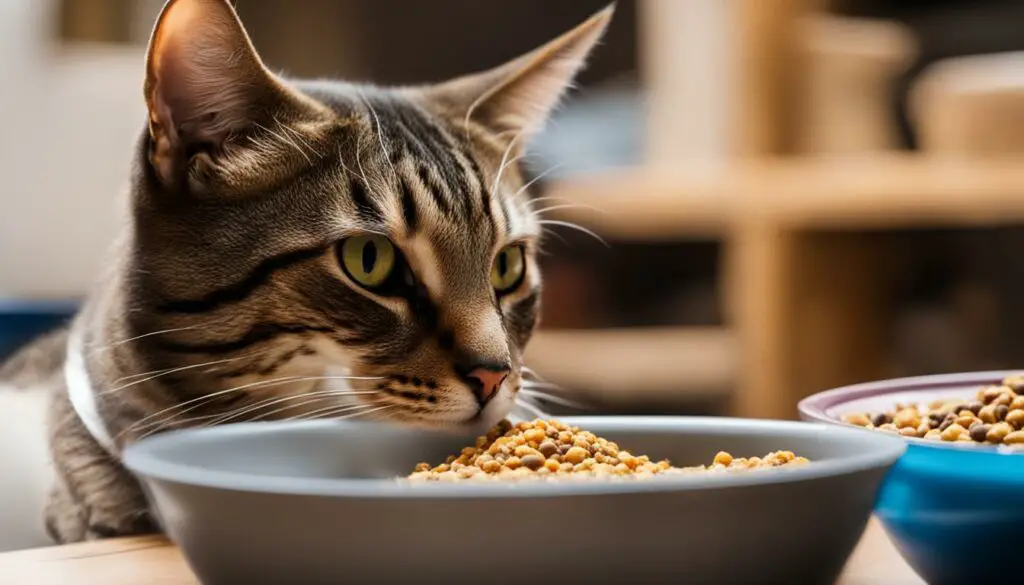
The Unique Nature of Feline Eating Quirks
Cats are fascinating creatures with their own set of quirks and habits when it comes to eating. Understanding and respecting these individual preferences is key to ensuring a harmonious mealtime routine for your feline companion. Whether it’s a specific ritual or a preference to eat when their owner is present, these quirks are part of what makes cats so unique.
Some cats may have particular rituals associated with mealtime, such as circling their food bowl before digging in or preferring a certain spot to eat. These routines may seem peculiar to us, but they are important to our feline friends. By observing and accommodating these quirks, we can create a more comfortable and enjoyable dining experience for our cats.
Just as humans have their own food preferences, cats also have tastes and textures they favor. Some cats may prefer wet food over dry kibble, while others may have specific flavor preferences. It’s essential to provide a variety of options and pay attention to what your cat enjoys most.
Tailoring their mealtime experience to match their preferences will not only ensure they receive the nutrition they need but also strengthen the bond between you and your cat. By understanding and embracing their unique eating quirks, we can create a harmonious mealtime routine that brings joy to both us and our feline companions.
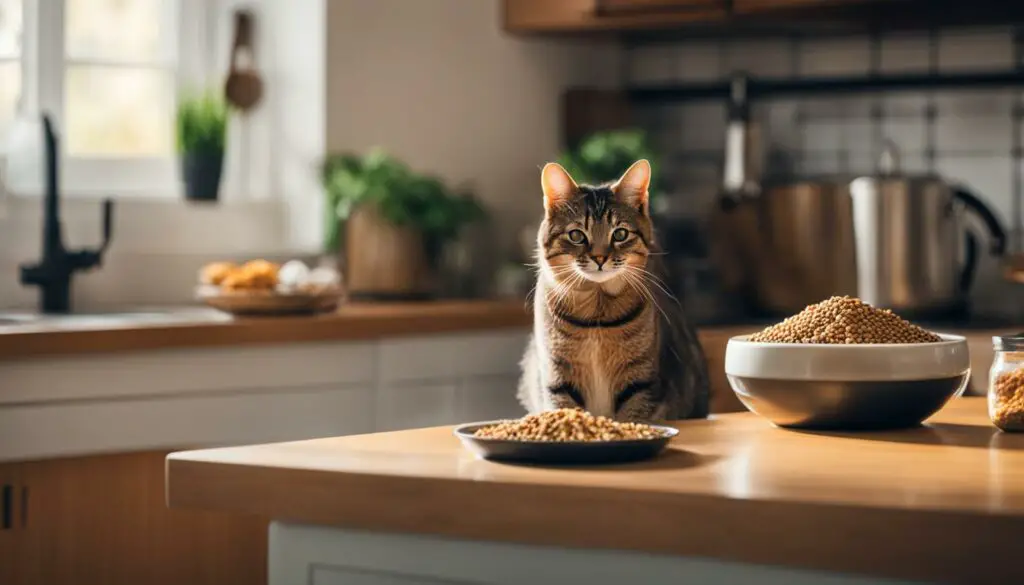
| Eating Quirk | Description |
|---|---|
| Circling Behavior | Some cats may circle their food bowl before eating. This behavior is a natural instinct, possibly derived from their wild ancestors who would circle around prey before consuming it. |
| Preference for Elevated Feeding | Many cats prefer to eat from an elevated position, such as a raised feeding bowl or a cat tree. This can help mimic their natural hunting posture and provide a sense of security while eating. |
| Preference for Fresh Food | Cats have a keen sense of smell and are often drawn to fresh food. They may show a preference for meals that are recently prepared or have strong aromas. |
| Specific Eating Spot | Some cats have a favorite spot where they like to eat. It could be a specific area of the house or a cozy corner. Providing a designated eating spot can make your cat feel more comfortable during mealtime. |
Creating a Harmonious Mealtime Routine
Establishing a harmonious mealtime routine for your cat is essential for ensuring their nutritional needs are met and that they have a positive dining experience. By understanding their unique behavior and tailoring their mealtime routine, you can promote their overall well-being and strengthen your bond with your feline companion.
Here are some key strategies to consider when creating a mealtime routine for your cat:
- Schedule regular mealtimes: Cats thrive on routine, so it’s important to establish consistent meal times. Set specific times for breakfast, lunch, and dinner, and stick to them as closely as possible. This routine will help regulate your cat’s appetite and provide a sense of predictability.
- Create a calm environment: Cats are sensitive to their surroundings, so it’s important to create a calm and quiet mealtime environment. Find a designated area for their meals where they can eat undisturbed. Minimize any loud noises or sudden movements that may startle or distract your cat while they’re eating.
- Monitor their food intake: Keep track of how much your cat is eating during each mealtime. This will help you ensure they’re getting the right amount of food and allow you to spot any changes in their eating patterns or appetite. If you notice a significant decrease in their food intake, it’s essential to consult with a veterinarian.
By following these strategies and adapting them to your cat’s specific needs, you can create a harmonious mealtime routine that ensures they receive the proper nutrition and feel comfortable during their meals. Remember, each cat is unique, so it may take some trial and error to find the routine that works best for your feline companion.
| Benefit of a Harmonious Mealtime Routine: | How to Achieve It: |
|---|---|
| Regulates your cat’s appetite and prevents overeating or undereating. | Schedule regular mealtimes and monitor their food intake. |
| Creates a sense of predictability and security for your cat. | Stick to a consistent mealtime schedule and create a calm environment. |
| Strengthens the bond between you and your cat. | Be present during their meals and engage in gentle interactions. |
| Allows you to monitor your cat’s eating habits and detect any changes in appetite or behavior. | Keep track of their food intake and consult a veterinarian if needed. |
Creating a harmonious mealtime routine is not only beneficial for your cat’s physical health but also for their emotional well-being. By providing a structured and calm environment, you can help them feel secure and content during meal times, strengthening the bond between you and your feline companion.
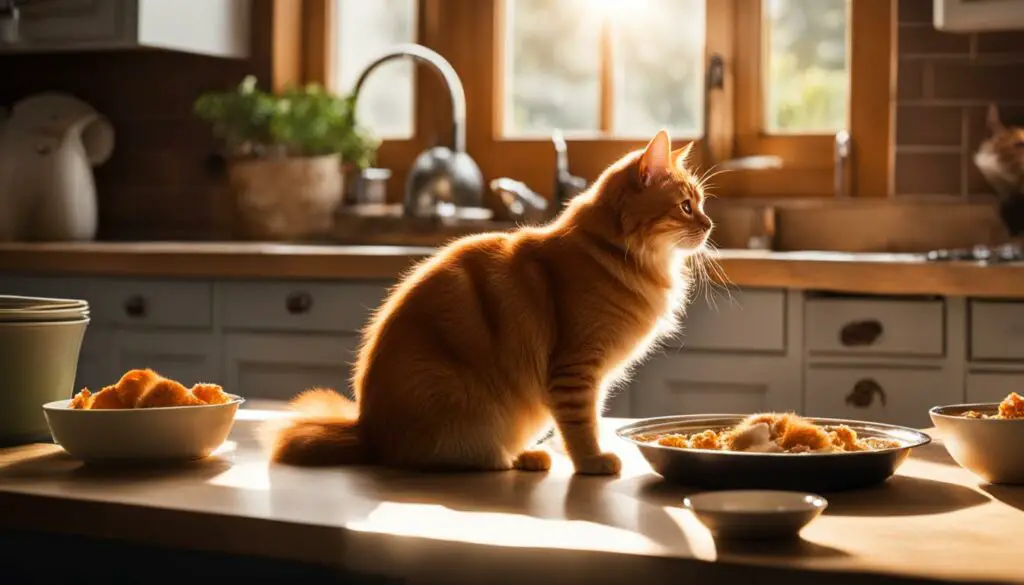
Conclusion
Understanding why your cat won’t eat unless you’re watching is crucial for creating a harmonious mealtime routine. This behavior is common among felines and can be attributed to various factors. Cats are interactive creatures who form strong bonds with their owners, and the presence of their owner during mealtime provides reassurance and security.
By observing and analyzing your cat’s eating patterns and preferences, you can gain insights into their motivations and tailor their mealtime experience accordingly. Some cats may have a preference for interactive mealtime experiences or seek attention from their owners while eating. Providing verbal encouragement, using interactive toys, and ensuring fresh and appealing food can encourage their eating.
It’s important to consider any underlying health issues that may be affecting your cat’s appetite. If your cat consistently refuses to eat unless you’re watching, consult with a veterinarian to rule out any physical causes. Creating a calm mealtime environment, establishing regular mealtimes, and understanding your cat’s unique behaviors are essential for promoting their well-being and strengthening your bond with them.
By recognizing and respecting your cat’s individual quirks and habits, you can create a harmonious mealtime routine that meets their nutritional needs and enhances their overall well-being. Remember to be present and attentive during their meals, engaging in gentle interactions to show them love and care. With a tailored approach and a focus on their specific needs, you can ensure a positive dining experience for your feline companion.
FAQ
Why does my cat refuse to eat unless I’m watching?
Cats may feel more secure and seek attention during mealtime when their owner is present.
What can I do to encourage my cat to eat when I’m not watching?
You can try sitting with them during mealtime, using interactive toys or puzzles, and ensuring the food is fresh and appealing.
Could there be underlying health issues causing my cat’s refusal to eat?
It’s recommended to consult with a veterinarian to rule out any medical conditions that may be affecting your cat’s appetite.
How can I address my cat’s finicky eating habits?
Experimenting with different types of food, ensuring appropriate temperature and texture, and feeding small, frequent meals can help.
How can I create a calm mealtime environment for my cat?
Find a designated area, minimize distractions, and create a serene environment to enhance your cat’s comfort during meals.
Why is it important to establish a consistent mealtime routine for my cat?
A regular routine can regulate your cat’s appetite and reduce their dependence on your presence during meals.
Why is understanding cat psychology important when it comes to their eating habits?
Understanding their behavior and needs can help you tailor their environment and routines to meet their specific requirements.
How can I strengthen the bond with my cat during mealtime?
Engage in gentle interactions like petting or talking to your cat while they eat to show them love and care.
What benefits can I gain from observing and analyzing my cat’s mealtime behavior?
It can provide valuable insights into their needs and preferences, helping you tailor their meals for a more enjoyable experience.
Are feline eating quirks unique to each cat?
Yes, every cat has individual eating habits, rituals, and preferences that should be respected and adapted to.
How can I create a harmonious mealtime routine for my cat?
Consider their preferences, create a calm environment, and provide regular meals at designated times to promote their well-being.
Why is understanding cat psychology important when it comes to their eating habits?
Understanding their behavior and needs can help you tailor their environment and routines to meet their specific requirements.
How can I strengthen the bond with my cat during mealtime?
Engage in gentle interactions like petting or talking to your cat while they eat to show them love and care.
What benefits can I gain from observing and analyzing my cat’s mealtime behavior?
It can provide valuable insights into their needs and preferences, helping you tailor their meals for a more enjoyable experience.
Are feline eating quirks unique to each cat?
Yes, every cat has individual eating habits, rituals, and preferences that should be respected and adapted to.
How can I create a harmonious mealtime routine for my cat?
Consider their preferences, create a calm environment, and provide regular meals at designated times to promote their well-being.

